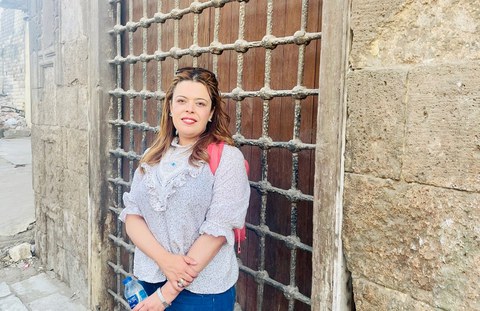Nov 04, 2022
Hala Ghoname - Neue Gastwissenschaftlerin am Institut für Kunst- und Musikwissenschaft
Name: Hala Ghoname
Chair: Chair of Visual Culture in the Global Context (Prof. Dr. Kerstin Schankweiler)
Institut: Institut of Art and Music
Faculty: Faculty of Arts, Humanities and Social Science
Hala Ghoname is a scholar and lecturer in the fields of Middle Eastern and North African Visual Politics, Art History, and Historic Preservation. Ghoname received her Bachelor’s degree from Roger Williams University in the United States, in 2008, in Historic Preservation and Art History. She also obtained her Master’s degree from the University of Hawaii, in 2012, with a thesis focusing on religious minorities’ arts of identity under the People’s Republic of China (Case study: Chinese Muslims' practices of Sini Script).
In July of 2021, Ghoname received her Ph.D. from the Philipps University of Marburg with a dissertation titled “The Wālī’s Soft Power in Europe: Orientalists’ Portraits of Muḥammad ‘Alī Bāshā; Between Historic Documentation, Political Propaganda, And the Sa’idian Paradigm of Orientalism”.
At TU Dresden Ghoname will be working on a new research project with the title „Digitizing Eternal Yesterday – Recycling the Past on Social Media as Means for Image Activism and the Interplay of Visual Politics Between Youth and Regimes in Post-Arab Spring Societies”.
What are your main interests as a researcher? Which topics do you focus on?
My research interests are heavily focused on visual culture, art, and image as means for sociopolitical mobilization, soft power, and visual diplomacy. Coming originally from Egypt, a country with an extended wealth of Islamic heritage, understanding the essence of oriental art formed my early interest in studying art history. After moving to the USA, and studying the basics of art criticism and contextual analysis, my interest shifted towards exploring how art worked as a tool for expressing subjectivity, resistance, and cultural, and ethnic identity. Believing in the visual vocabulary of art, I started investigating it in the framework of intercultural means of communication, way before the invention of modern technology. I looked at how art formed perceptions and served political agendas; hence, for my Ph.D., I revisited the Sa'idian paradigm of orientalism to examine how orientalist art worked as a device, not in the hand of the orientalist artist, but, contrary to Said's hypothesis, under the control of the oriental entity who had commissioned it with the purpose of taking part in a growing tradition of visual diplomacy from the nineteenth century onward. Hereafter, Art and the visual past of the MENA region formed the heart of my current research focus; therefore, I currently work on how this legacy of politically loaded visuals is being recycled by youth, who had never lived that past, on social media to debate the present's sociopolitical and economic conditions.
What was your most interesting research topic so far?
Actually, all were interesting; however, there is another research that I am currently developing, parallel and fairly related to my current project at TU Dresden. It is rather thought-provoking as it focuses on the Arabic-illustrated journals within the global propaganda program of the GDR. These tabloids were loaded with a surplus of images from the MENA region and as proof of wide circulation, copies of which were to be found in the bookselling districts of Cairo, Damascus, and Baghdad.
What does your current research focus on?
My current research project carries the title “Digitizing Eternal Yesterday – Recycling the Past on Social Media as Means for Image Activism in Post-Arab Spring Societies”. What my current project endeavors to make is related to emphasizing how the past’s visual relics have been revived and reshaped through digitizing eternal yesterday in post-Arab-Spring societies and their deployment as harmless metaphors for youth protest vs. their handling as normative legitimation devices by state propagandists.
Which item do you absolutely need at your workplace?
I would, indeed, put it in a plural form to say items; hence, I need a computer so I could use digital images search engines and social media platforms for images, memes, cartoons, ...etc., a good software trained to help me trace patterns of digital image sharing and dissemination, and, finally, a notebook and a pencil to write down my notes.
Do you have a favourite quote? If so, what is it and from whom?
"Every great dream begins with a dreamer. Always remember, you have within you the strength, the patience, and the passion to reach for the stars to change the world." -- Harriet Tubman
"We all should rise, above the clouds of ignorance, narrowness, and selfishness." -- Booker T. Washington
Which book did you recently read? / Which movie/series did you watch recently?
But it is Art by Cynthia Freeland; It is a book that discusses art in today’s context of innovation and controversy in relation to beauty, culture, and politics.
More information: https://www.facebook.com/Hala.h.Ghonaim/

